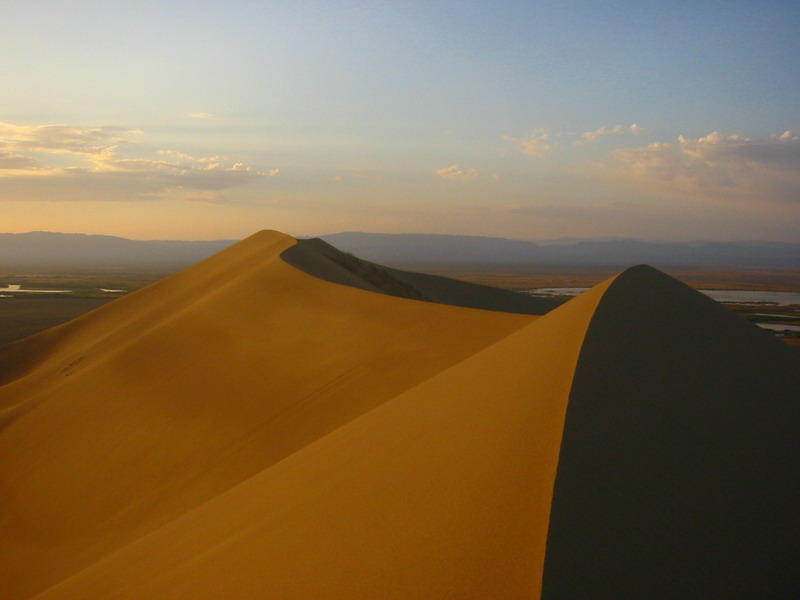
Song of Dunes
…when travellers are on the move by night, and one of them chances to lag behind or to fall asleep or the like, when he tries to gain his company again he will hear spirits talking, and will suppose them to be his comrades. Sometimes the spirits will call him by name; and thus shall a traveller ofttimes be led astray so that he never finds his party. And in this way many have perished. [Sometimes the stray travellers will hear as it were the tramp and hum of a great cavalcade of people away from the real line of road, and taking this to be their own company they will follow the sound; and when day breaks they find that a cheat has been put on them and that they are in an ill plight.] Even in the day-time one hears those spirits talking. And sometimes you shall hear the sound of a variety of musical instruments, and still more commonly the sound of drums.
— Marco Polo, Book of the Marvels of the World, c. 1300
Famed explorer Marco Polo trekked through the Gobi Desert during his Silk Road excursions. Arid climes are notorious for playing tricks on the human mind. When Marco Polo encountered something odd emanating from the endless wasteland, his 13th-century brain conjured spirits, sand sirens looking to lure humans to doom.
If you’ve spent time at many beaches across the globe or even in sandboxes or outdoor volleyball courts, you might already guess spirits are not to blame for the sounds he experienced in the desert. If you have heard the squeak of certain sands as you move your feet through them, you have experienced singing sand. Sometimes we call it whistling sand or barking sand.
If you have no idea what I’m talking about, watch this video:
Sand that produces sound when disturbed, whether by wind or human feet, is described as singing sand.
Not all sandy spots create noise. Though we do not completely understand the scientific reasoning behind singing sand, researchers have nailed down some attributes needed for the phenomenon. Silica must be present. Conglomerate sands high in ground-up shells or other detritus will not produce music. The grains must be largely homogenous: between 0.1 and 0.5 millimeters in diameter and rounded from erosion. Humidity and water content must fall within specific parameters. If the ingredients aren’t right, you get silent sand.
Of course, we owe a bit of an apology to Marco Polo. Though singing sand on beaches is intriguing, he did not conjure deadly spirits to explain this tiny marvel.
Marco Polo most likely encountered the much bigger cousin of singing sands: booming dunes.

At certain spots in the world, deserts produce the “Song of Dunes.”
When conditions are right, some dunes create a unique, loud humming.
Check out a short clip from Great Sand Dunes National Park in Colorado:
In nature, this droning arises thanks to the wind. When gusts destabilize the top layer of sand on a dune, it can cause an avalanche. As sand particles slide down the dune, they produce shear. If the composition of the dune is just right, this shearing creates a wondrous symphony.
Geophysicists believe the booms arise because of the stratification of sand. Hot temperatures and sunlight can dry a layer close to the surface. When sand particles shear, causing vibrations, the energy does not penetrate wetter layers but instead amplifies within the top portions. Like the string of a violin, the top layer of sand vibrates the air, which disseminates the hum to the surrounding region.
Booming dunes are not quiet, either. Researchers have measured the happening at up to 105 decibels. That measurement is louder than a jackhammer or a jet flying overhead at 1000 feet. The songs can last for many minutes. From this frame of reference, it’s easy to see how Marco Polo might attribute the mysterious cacophony to evil spirits.
Interestingly, the songs can be conjured by humans. As shown in the video above, researchers slide down the dues to create the avalanches necessary to trigger a boom.
For the musically inclined, dunes produce single notes. Depending on the thickness of the top layer, the pitch of the desert is either G, E, or F.
Though spirits ultimately do not drone in the desert, there is something inherently alluring about the tones. I feel I could listen to the hum for hours and find myself lost. I’m not sure how to describe this attribute, but it’s as if one can hear the naturalness of the sounds. Almost as if one is hearing a fundamental property of the universe.
It’s a truly remarkable vibration. Come to think of it, an attribution to spirits doesn’t sound so bad, after all. Though I would lop off the “evil” tag. I hope to one day experience these songs in person.
Further Reading and Exploration
What are “booming sands” and what causes the sounds they make? – Scientific American
Singing Sand Dunes Explained – National Geographic
Booming Sand Dunes Research – Cal Tech
Symphony of the sands – The National News













